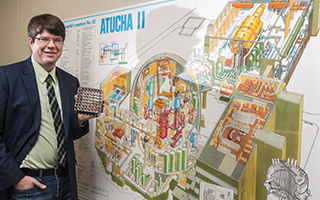
Sandia nuclear engineer Matt Denman (6231) had an interesting journey just prior to coming to Sandia, which he shared with attendees during the opening of the February edition of NMPBS’ Science Café, held at the National Museum of Nuclear Science and History.
In early 2011, after defending his PhD thesis in nuclear engineering at the Massachusetts Institute of Technology, Matt attended a risk analysis conference in North Carolina. During that conference, Japan was struck by the 9.1-magnitude Great East Japan Earthquake and the subsequent tsunami that resulted in the Fukushima Daiichi nuclear power accident.
“I was trapped with a bunch of risk analysts in North Carolina during the accident. These engineers had spent their entire lives studying how nuclear power plants could melt down, which is either the best place to be or the worst place to be,” Matt says.
Matt had defended his PhD thesis a few weeks earlier incorporating risk insights into the design of a sodium-cooled fast reactor. He had limited his analysis scope to include only internally induced accidents while acknowledging that the true limiting risks of these reactors would come from external events such as floods and earthquakes. While this limitation in research scope was acceptable to his thesis committee in February, had he waited to defend until after the Fukushima reactor accident in March, he likely would have been forced to expand the scope of his thesis to include external events, which could have added another year of research time to his thesis.
You’d think that beginning one’s professional life concurrent with the largest nuclear accident might make a risk analyst less bullish on nuclear power. But you’d be wrong.
Matt says one of the reasons he became a nuclear engineer is because energy is a key component to ensuring a good quality of life for Americans and for the rest of the world. For business, and to extend the work week, the world needs lots of electricity. And overall, nuclear power provides the cheapest electricity safely, he says.
“Based on the data, nuclear power is far safer than other types of power generation. But people don’t think of it that way, because they focus on the accidents at Chernobyl and Fukushima rather than the millions of people who die from pollution from other energy sources,” Matt says.
People don’t think about the risks associated with everyday activities, such as driving a car. They focus on the risks associated with things they don’t have any control over, no matter how unlikely those events are, Matt says.
“Humans evaluate things in terms of dread. We will engage in extremely risky activity if we think we have some control over it. We discount the everyday risk, and we overestimate the risk of something like a nuclear accident, over which we have very little control,” Matt says.
Matt says the nuclear industry does very expensive testing to characterize the risk of nuclear power plants, which other industries do not do. But even characterizing that risk accurately does not seem to help overcome the dread associated with nuclear power, no matter how safe it’s proven to be.
“Part of my research is to study how different types of nuclear power plants can fail, and how different forms of electricity can kill you. I spend a lot of my time calculating ‘deaths per year.’ It’s a little warped, but incredibly important.”
After all his research of all the different types of electricity generation available, Matt says he has concluded that nuclear energy is among the safest.
“Fukushima did not change my view of nuclear power. Nuclear power is the cleanest option I have seen so far. But all human activities have pros and cons; there is no free lunch, but nuclear power is a cheaper lunch.”
Matt is currently studying the risks of fire associated with sodium-cooled fast reactors.
The March Science Café will feature Leigh Ann Steele (2546) discussing battery research. Leigh Ann was one of two Sandia researchers who appeared in NOVA’s recent episode “Super Battery.”